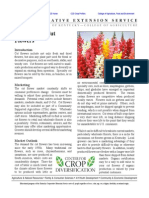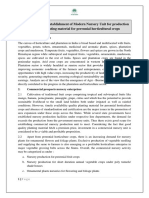Nursery
Nursery
Uploaded by
Erwin Y. CabaronCopyright:
Available Formats
Nursery
Nursery
Uploaded by
Erwin Y. CabaronOriginal Title
Copyright
Available Formats
Share this document
Did you find this document useful?
Is this content inappropriate?
Copyright:
Available Formats
Nursery
Nursery
Uploaded by
Erwin Y. CabaronCopyright:
Available Formats
Name:
Year & Section:
Reflection Paper
1. Determine the plant types available for sale at the new nursery. Greenhouses
specializing in blooming varieties of plants, such as flowers and ornamental pieces,
require different amounts of light and humidity from those that grow fruit-bearing
plants or ground cover species.
2. Register with the local Department of Agriculture to receive nursery certification.
Each state determines its own rules for certification and sets the fees for this
recognition. Provide a listing of plants or plant types and indicate familiarity with safety
regulations for plant health and growth. Most states also require a Sales and Use Tax
Certificate, available from the Secretary of State, for any retail sales of plants or other
goods.
3.
Determine the correct manner of display for the business. Vegetables and herbs may
require stands to keep them from sitting in water or potentially hazardous runoffs.
Ground cover plants thrive when planted directly in the earth and allowed to develop
native root systems. Shops specializing in trees or shrubs require display pots and large
areas of open space for growth.
4.
Locate a wholesale seed or seedling vendor. Reputable vendors offer wholesale
discounts to other businesses and require proof of official business status such as a
federal Employer Identification Number or Articles of Incorporation. Many also require
proof of official certification.
5.
Purchase seeds, fertilizers, displays and any other incidentals such as inventory or cash-
handling systems. These items transform the location into a place of business and allow
a well-informed small-business owner to begin sales at the new plant nursery.
You might also like
- Marijuana: Growing Marijuana: Beginners To Experts Ultimate Easiest Guide For Growing Large Buds Of Marijuana Plants .The Grow Bible To Get Big Yields In Small Places Indoors And OutdoorsFrom EverandMarijuana: Growing Marijuana: Beginners To Experts Ultimate Easiest Guide For Growing Large Buds Of Marijuana Plants .The Grow Bible To Get Big Yields In Small Places Indoors And OutdoorsNo ratings yet
- Field Nursery Production: Cheryl Kaiser and Matt ErnstDocument5 pagesField Nursery Production: Cheryl Kaiser and Matt ErnstMeroveokingNo ratings yet
- Container Gardening: A Complete Beginners Guide to Thriving Plants in Any SpaceFrom EverandContainer Gardening: A Complete Beginners Guide to Thriving Plants in Any SpaceNo ratings yet
- Lecture - 15 PDFDocument5 pagesLecture - 15 PDFIndu LekhaNo ratings yet
- 43floricultural Production and Management - 210313 - 004203Document19 pages43floricultural Production and Management - 210313 - 004203zaphiratNo ratings yet
- PVP Form 1-Application FormDocument7 pagesPVP Form 1-Application FormJoeluntalanNo ratings yet
- 7640 Seed Starting Transplanting GuidelinesDocument5 pages7640 Seed Starting Transplanting GuidelinesAlexandra BellaNo ratings yet
- PVP Form 2-Exhibit ADocument2 pagesPVP Form 2-Exhibit AJoeluntalanNo ratings yet
- 045 Intro To HerbsDocument4 pages045 Intro To HerbsTaylan SekerciNo ratings yet
- Plant Propagation - Basic Princi - Brian WhipkerDocument6 pagesPlant Propagation - Basic Princi - Brian WhipkerAja ASNo ratings yet
- The Homesteading Handbook: A Back to Basics Guide to Growing Your Own Food, Canning, Keeping Chickens, Generating Your Own Energy, Crafting, Herbal Medicine, and MoreFrom EverandThe Homesteading Handbook: A Back to Basics Guide to Growing Your Own Food, Canning, Keeping Chickens, Generating Your Own Energy, Crafting, Herbal Medicine, and MoreRating: 5 out of 5 stars5/5 (1)
- PlantsDocument1 pagePlantsMARDIYAH BINTI RAHIM KPM-GuruNo ratings yet
- HeirloomDocument4 pagesHeirloomImpasto PhospheratoNo ratings yet
- Agrovet Business Guide - PDFDocument25 pagesAgrovet Business Guide - PDFbazaqiyaNo ratings yet
- Guidelines For Repackaging PesticidesDocument1 pageGuidelines For Repackaging PesticidesMichelle du Toit100% (1)
- Seed Marketing by Tony StrattonDocument7 pagesSeed Marketing by Tony StrattonTANGGUH RANGGIYUWANA IZZA IPBNo ratings yet
- CPT 103 - Lecture2Document51 pagesCPT 103 - Lecture2Esperanza CañaNo ratings yet
- Seeds Bill-Complete AnalysisDocument8 pagesSeeds Bill-Complete AnalysisBabuNo ratings yet
- Title 61 Legislative Rule Department of Agriculture Series 9 West Virginia Seed LawDocument32 pagesTitle 61 Legislative Rule Department of Agriculture Series 9 West Virginia Seed LawViolintsarNo ratings yet
- Law of Intellectual Property Compensatory ASSIGNEMT 2Document6 pagesLaw of Intellectual Property Compensatory ASSIGNEMT 2Letty SissyNo ratings yet
- Home Gardening: Bob Westerfield UGA Extension HorticulturistDocument20 pagesHome Gardening: Bob Westerfield UGA Extension HorticulturistKandice LedfordNo ratings yet
- Self-Sufficiency: A Complete Guide to Baking, Carpentry, Crafts, Organic Gardening, Preserving Your Harvest, Raising Animals, and More!From EverandSelf-Sufficiency: A Complete Guide to Baking, Carpentry, Crafts, Organic Gardening, Preserving Your Harvest, Raising Animals, and More!No ratings yet
- Cut FlowersDocument3 pagesCut FlowersZsolt LőrinczyNo ratings yet
- Starting A NurseryDocument6 pagesStarting A Nurserydexter.plc005No ratings yet
- Seed ProductionDocument16 pagesSeed ProductionRaphaelNo ratings yet
- Agriculture 6 Week 3 Powerpoint PresentationDocument35 pagesAgriculture 6 Week 3 Powerpoint PresentationJC Cailao100% (5)
- Principles of Seed Technology NotesDocument134 pagesPrinciples of Seed Technology NotesRamyaNo ratings yet
- HELE4 2ndQ ReviewerDocument15 pagesHELE4 2ndQ ReviewerHoney Lagarde-PanolNo ratings yet
- LL About /: Live Stock /poultryDocument3 pagesLL About /: Live Stock /poultryTariq Hussain KhanNo ratings yet
- Seed Commerce Regulations in ChileDocument6 pagesSeed Commerce Regulations in Chileyoshiyahu613No ratings yet
- Why Does Countries Formulated Trade Barriers Through Tariffs?Document4 pagesWhy Does Countries Formulated Trade Barriers Through Tariffs?mars ortegaNo ratings yet
- Tle Agri Grade 6 Module 6Document5 pagesTle Agri Grade 6 Module 6Maribel A. Bustillo100% (2)
- A Beginner's Guide To Poultry FarmingDocument3 pagesA Beginner's Guide To Poultry FarmingBashir JunejoNo ratings yet
- Emergence and Origin of PVPDocument5 pagesEmergence and Origin of PVPAnurag MaheshwariNo ratings yet
- 6 Lemon EstablishmentDocument11 pages6 Lemon EstablishmentCharles Joseph MaldiaNo ratings yet
- QuestionnareDocument8 pagesQuestionnareManmeet SinghNo ratings yet
- Rules and RegDocument4 pagesRules and Regapi-310033947No ratings yet
- Cultural PracticesDocument3 pagesCultural PracticesrexazarconNo ratings yet
- Nursery ReportDocument5 pagesNursery Reportarifeen_091No ratings yet
- PPV&FR 070908Document10 pagesPPV&FR 070908LakshmipriyaNo ratings yet
- PV Act 2001Document18 pagesPV Act 2001shivannageetha01No ratings yet
- General Standards06Document11 pagesGeneral Standards06Sai Srinivas MadaNo ratings yet
- Starting A Food Business: Canning: LicensingDocument4 pagesStarting A Food Business: Canning: Licensingkristine de vale100% (1)
- Houseplant Care Guide by Plants AliveDocument88 pagesHouseplant Care Guide by Plants AlivesamacharshopperNo ratings yet
- License Application Instructions For Plant VarietiesDocument4 pagesLicense Application Instructions For Plant Varietiesjeesup9No ratings yet
- How To Shop Plants Safely From IndonesiaDocument2 pagesHow To Shop Plants Safely From IndonesiaMutia YulizaNo ratings yet
- Hosplect-8 2Document8 pagesHosplect-8 2mm3289No ratings yet
- PPQ587Document2 pagesPPQ587johnsonkk125No ratings yet
- CastilloKKD RA 9168Document28 pagesCastilloKKD RA 9168Kathleen CastilloNo ratings yet
- Collecting Pressing ProtocolsDocument6 pagesCollecting Pressing ProtocolsAsma BzourNo ratings yet
- Babylonica Var. Pekinensis Tortuosa' and The Corkscrew Hazel Corylus Avellana Redmajestic'Document2 pagesBabylonica Var. Pekinensis Tortuosa' and The Corkscrew Hazel Corylus Avellana Redmajestic'Azaam AliNo ratings yet
- 204 ORO - Nursery Management Participant Material Module 1Document20 pages204 ORO - Nursery Management Participant Material Module 1Yared AlemnewNo ratings yet
- Model Scheme On Setting Up of High Tech Nursery Under Plantation and HorticultureDocument15 pagesModel Scheme On Setting Up of High Tech Nursery Under Plantation and HorticultureSuresh Kumar Vengali100% (1)
- Plant GrowthDocument3 pagesPlant GrowthdanielgabreelsNo ratings yet
- p1828 WebDocument36 pagesp1828 WebMohammed PastawyNo ratings yet
- Faq PpvfraDocument10 pagesFaq Ppvframanisha maniNo ratings yet
- Vege Production 07052021Document117 pagesVege Production 07052021Kesh YahNo ratings yet
- Revealed That The MainDocument23 pagesRevealed That The MainErwin Y. CabaronNo ratings yet
- Micro Perspectives On Tourism and Hospitality Chapter 1:tourism Industry and EconomyDocument24 pagesMicro Perspectives On Tourism and Hospitality Chapter 1:tourism Industry and EconomyErwin Y. CabaronNo ratings yet
- Factors Influencing Secondary School Students To Steal and Their Need For Guidance and Counselling in Bungoma West District, Bungoma County in KenyaDocument5 pagesFactors Influencing Secondary School Students To Steal and Their Need For Guidance and Counselling in Bungoma West District, Bungoma County in KenyaErwin Y. CabaronNo ratings yet
- Values Education For Public IntegrityDocument41 pagesValues Education For Public IntegrityErwin Y. CabaronNo ratings yet
- Values Education Why The Teaching of Values in Schools Is Necessary But Not SufficientDocument1 pageValues Education Why The Teaching of Values in Schools Is Necessary But Not SufficientErwin Y. CabaronNo ratings yet
- A Conceptual Exploration of Values Education in The Context of Schooling in South AfricaDocument12 pagesA Conceptual Exploration of Values Education in The Context of Schooling in South AfricaErwin Y. CabaronNo ratings yet
- Benefits of Value Education in SchoolDocument2 pagesBenefits of Value Education in SchoolErwin Y. CabaronNo ratings yet
- Memorandum: AgreementDocument10 pagesMemorandum: AgreementErwin Y. CabaronNo ratings yet
- Self-Care: Good For You and Your Work: Ellen Newman Projects Coordinator Hunter Institute of Mental HealthDocument36 pagesSelf-Care: Good For You and Your Work: Ellen Newman Projects Coordinator Hunter Institute of Mental HealthErwin Y. CabaronNo ratings yet
- SUN Self Care PlanDocument7 pagesSUN Self Care PlanErwin Y. Cabaron100% (1)
- How To Create An Individualized Self-Care Plan: Step 1. Learn About The Importance of Self-CareDocument7 pagesHow To Create An Individualized Self-Care Plan: Step 1. Learn About The Importance of Self-CareErwin Y. CabaronNo ratings yet
- People Have More Control Over Their LivesDocument7 pagesPeople Have More Control Over Their LivesErwin Y. CabaronNo ratings yet
- Report Saturday For TeacherDocument7 pagesReport Saturday For TeacherErwin Y. CabaronNo ratings yet
- Report On SaturdayDocument21 pagesReport On SaturdayErwin Y. CabaronNo ratings yet
- Report SatDocument17 pagesReport SatErwin Y. CabaronNo ratings yet
- People Have More Control Over Their LivesDocument2 pagesPeople Have More Control Over Their LivesErwin Y. CabaronNo ratings yet
- Social Dimension of EducationDocument15 pagesSocial Dimension of EducationErwin Y. CabaronNo ratings yet












































































